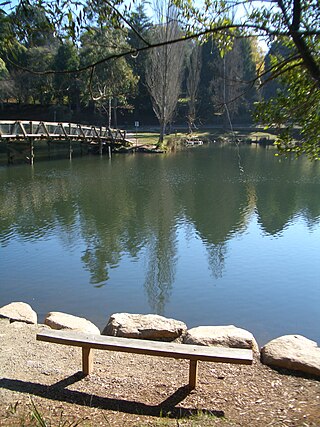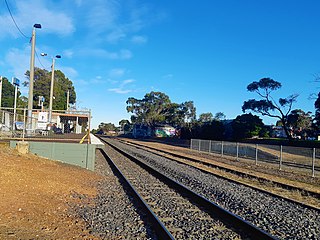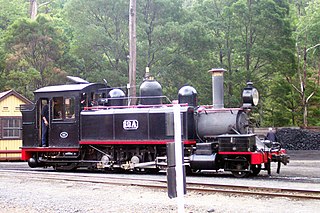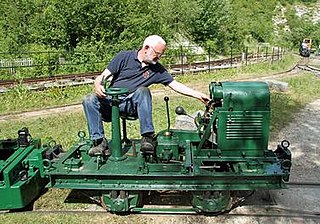
The Dandenong Ranges are a set of low mountain ranges in Victoria, Australia, approximately 35 km (22 mi) east of the state capital Melbourne. A minor branch of the Great Dividing Range, the Dandenongs consist mostly of rolling hills, rising to 633 m (2,077 ft) at Mount Dandenong, as well as steeply weathered valleys and gullies covered in thick temperate rainforest, predominantly of tall mountain ash trees and dense ferny undergrowth. The namesaked Dandenong Creek and most of its left-bank tributaries originate from headwaters in these mountain ranges. Two of Melbourne's most important storage reservoirs, the Cardinia and Silvan Reservoir, are also located within the Dandenongs.

The Puffing Billy Railway is a 2 ft 6 in narrow gauge heritage railway in the southern foothills of the Dandenong Ranges in Melbourne, Australia. The railway was one of the five narrow gauge lines of the Victorian Railways which opened around the beginning of the 20th century. It is close to the city of Melbourne and is one of the most popular steam heritage railways in the world, attracting tourists from Australia and overseas. The railway aims to preserve and restore the line as near as possible to how it was in the first three decades of its existence, but with particular emphasis on the early 1920s.

Emerald is a town in the Greater Melbourne area of Victoria, Australia, 44 km south-east of Melbourne's Central Business District, located within the Shires of Cardinia and Yarra Ranges local government areas. Emerald recorded a population of 5,890 at the 2021 census.

Somerville railway station is located on the Stony Point line in Victoria, Australia. It serves the town of Somerville, and it opened on 10 September 1889.

Menzies Creek railway station, formerly known as Aura railway station, is located on the Puffing Billy Railway in the town of the same name.

Emerald railway station is situated on the Puffing Billy Railway in Victoria, Australia. It was opened with the Railway on 18 December 1900 and comprised a platform track and a loop siding.

Nobelius railway station is situated on the Puffing Billy Railway, and opened in 1927. It was named after the founder of the nearby Gembrook Nurseries, Carl Axel Nobelius, and his family.

Lakeside railway station is situated on the Puffing Billy Railway in Melbourne, Australia. It was opened in 1944 to serve Emerald Lake Park, a popular picnic and recreation reserve created during World War II. The station originally consisted of a short single-face platform on the up side of the line, approximately on the site of the current locomotive water tanks. It had a name board and a red flag for intending passengers to signal to the train crew, but no shelter.

Cockatoo railway station is situated on the Puffing Billy Railway in the town of the same name. It opened with the line on 18 December 1900 as Devon, but was renamed Cockatoo Creek on 29 July 1901 and subsequently shortened to Cockatoo in 1904. There was originally a platform road and a loop siding, but a crossing loop was later added in between the two. A single 12ft by 20 ft timber portable station building was provided which was later extended. Other associated buildings such as toilets and a van good shed were also on the platform while a weatherboard goods shed was provided on the loop siding.

Cockatoo is a town in Victoria, Australia, 48 km south-east of Melbourne's central business district, located within the Shire of Cardinia local government area. Cockatoo recorded a population of 4,408 at the 2021 census.

Bridgehouses railway station was the terminal station of the Sheffield, Ashton-under-Lyne and Manchester Railway from its opening in 1845 until the opening of the Wicker Arches, a 660-yard (600 m) long viaduct across the Don Valley, which supported the new Sheffield Victoria opened on 15 September 1851. On 1 January 1847 a half-mile connecting line to the Wicker station of the Midland Railway had been constructed in order to increase goods traffic and enable wagon transfers. This short steeply graded line, enclosed within a tunnel for almost its entire length was known locally as the Fiery Jack.

Toddington railway station serves the village of Toddington in Gloucestershire, England. Since 1984 it has been the main base of operations for the heritage Gloucestershire Warwickshire Railway.

The former Victorian Railways, the state railway authority in Victoria, Australia, built a number of experimental 2 ft 6 in narrow-gauge lines around the beginning of the 20th century. Although all were closed by the early 1960s, parts of two have been reopened as heritage railways.
Clematis is a town in Victoria, Australia, 42 km south-east from Melbourne's central business district, located within the Shire of Cardinia local government area. Clematis recorded a population of 352 at the 2021 census.

The Victorian Railways NA class is a 2-6-2 tank locomotive built for their four 2 ft 6 in gauge branch lines.

The Oregon Nursery Company was a nursery company founded and originally operated in Salem, Oregon, United States. The company later expanded to a site in Washington County, Oregon west of Portland. The entire operation was eventually moved to Washington County, where the company founded the town of Orenco. The company went bankrupt in 1927. Its legacy is the Orenco place name that is still widely used in the Hillsboro area.
Unlike the broad-gauge, the Victorian Railways' 2 ft 6 in narrow-gauge network never had four-wheeled trucks. Instead, a single design of 249 underframes was constructed, with identical structure, bogies, couplers and brake equipment. Different bodies were provided on these frames for each purpose. The most common, by far, was the convertible flat/open truck, followed by cattle, louvred, insulated and boxcar types.

Lenzie Peat Railway was a narrow-gauge railway which ran on Lenzie Moss, which is situated to the west of the town of Lenzie in Scotland.
This article outlines the history and types of passenger rolling stock and guards vans on the narrow-gauge lines of the Victorian Railways in Australia. The types were constructed in parallel with very similar designs.

Princeton Nurseries was a large commercial plant nursery located near Kingston in the township of South Brunswick, extending into the township of Plainsboro, in Middlesex County, New Jersey, United States. Founded in 1913 by William Flemer Sr., it once was the largest commercial nursery in the United States. The company stopped operations here in 1995. It was added to the National Register of Historic Places as the Princeton Nurseries Historic District on August 28, 2018, for its significance in agriculture and architecture. The 272-acre (110 ha) historic district includes 40 contributing buildings, three contributing structures and one contributing site.

















